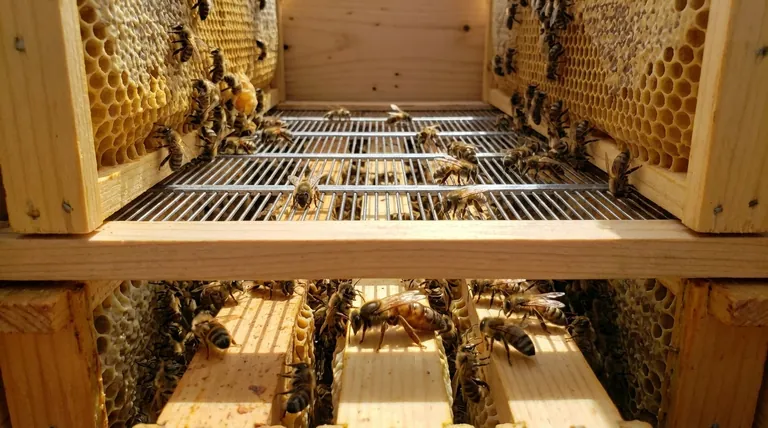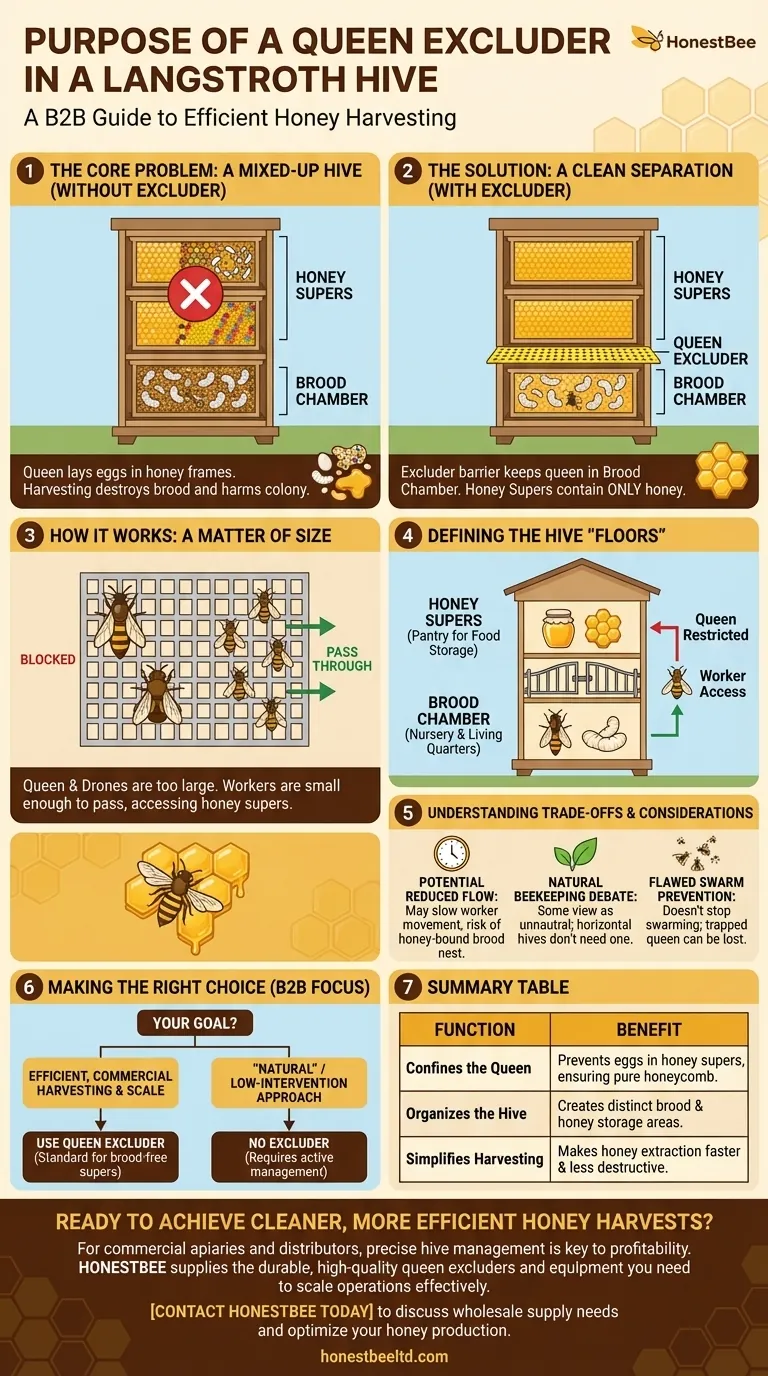In short, a queen excluder is a purpose-built barrier that separates the queen bee from the rest of the hive. It is a perforated sheet, made of metal or plastic, with openings large enough for smaller worker bees to pass through but too small for the larger queen and drones. Its primary function is to confine the queen to the brood chamber, preventing her from laying eggs in the honey supers above.
The central purpose of a queen excluder is to enforce a clean separation between the brood-rearing area and the honey storage area. This control makes honey harvesting vastly simpler and more efficient for the beekeeper.

The Core Problem: A Mixed-Up Hive
To understand the value of an excluder, you must first understand the problem it solves. Without one, the queen is free to roam the entire hive, laying eggs wherever she deems suitable.
The Challenge of Honey Extraction
When a queen lays eggs in the frames designated for honey storage (the "honey supers"), you get a mixture of honey, pollen, and brood (eggs, larvae, and pupae) in the same comb.
Harvesting honey from these "brood-heavy" frames is nearly impossible without destroying the developing bees, which harms the colony's future workforce. The excluder ensures honey supers contain only honey.
The Need for a Dedicated Brood Nest
A healthy hive relies on a well-organized brood nest, typically a compact sphere across several frames in the lower boxes. This allows the colony to efficiently regulate the temperature and humidity required for raising young bees.
An excluder helps reinforce this natural tendency by creating a definitive boundary for the queen's domain.
How a Queen Excluder Solves the Problem
The excluder is a simple but highly effective tool for hive management, particularly in the vertical Langstroth hive design.
A Simple Matter of Size
The entire mechanism is based on anatomy. The queen bee and male drones are physically larger than the female worker bees. The excluder's grid is precisely sized to exploit this difference, acting as a selective gate.
Defining the Hive's "Floors"
Think of the hive as a multi-story building. The bottom boxes are the "brood chamber"—the nursery and living quarters. The upper boxes are the "honey supers"—the pantry.
The queen excluder acts as a partition between these floors, ensuring the pantry is used exclusively for food storage.
Proper Placement and Introduction
The excluder is placed directly on top of the uppermost brood box, just before the first honey super is added.
To encourage bees to move up and through the excluder, beekeepers often "bait" the new super. This involves moving a frame containing sealed brood or honey from the brood box into the super above the excluder, drawing nurse bees upward to care for the brood or store nectar.
Understanding the Trade-offs
While indispensable for many, queen excluders are a subject of debate among beekeepers. It is critical to understand their potential downsides.
Potential for Reduced Honey Flow
Some beekeepers argue that the barrier, however slight, can slow down worker bees traveling between the brood nest and honey supers. This friction can sometimes lead to a "honey-bound" brood chamber, where bees backfill the nest with nectar instead of crossing the excluder.
The "Natural Beekeeping" Perspective
Proponents of natural beekeeping often avoid excluders, viewing them as an unnatural intervention. In horizontal hives, for instance, the queen naturally keeps her brood nest consolidated, making an excluder unnecessary. Forgoing an excluder in a vertical hive requires more hands-on management to keep the queen in check.
A Flawed Swarm Prevention Tool
An excluder is sometimes placed on the bottom board to prevent a queen from leaving with a swarm. This is a poor solution because it does not address the root cause of swarming (like overcrowding). The colony will still attempt to swarm, and the trapped queen can be lost or killed in the process.
Making the Right Choice for Your Hive
The decision to use a queen excluder depends entirely on your beekeeping goals and philosophy.
- If your primary focus is clean, efficient honey harvesting: Using a queen excluder is the standard and most reliable method to guarantee brood-free honey supers.
- If your primary focus is commercial-scale beekeeping: The excluder is an essential tool for managing many hives and pulling honey supers quickly without risk to the queen.
- If your primary focus is a "natural" or low-intervention approach: You can choose not to use an excluder, but you must be prepared to actively manage your frames to prevent the queen from filling honey supers with brood.
Ultimately, the queen excluder is a tool that gives you, the beekeeper, precise control over the internal structure of your hive.
Summary Table:
| Function | Benefit |
|---|---|
| Confines the Queen | Prevents eggs in honey supers, ensuring pure honeycomb. |
| Organizes the Hive | Creates distinct brood and honey storage areas. |
| Simplifies Harvesting | Makes honey extraction faster and less destructive. |
Ready to achieve cleaner, more efficient honey harvests?
For commercial apiaries and distributors, precise hive management is key to profitability. HONESTBEE supplies the durable, high-quality queen excluders and beekeeping equipment you need to scale your operations effectively.
Contact HONESTBEE today to discuss your wholesale supply needs and optimize your honey production.
Visual Guide

Related Products
- Premium Wood Framed Metal Wire Queen Bee Excluder
- Professional Plastic Queen Excluder for Modern Beekeeping
- Plastic Queen Bee Excluder for Bee Hive Wholesale
- High Performance Plastic Queen Excluder for Beekeeping and Apiary Management
- Wooden Queen Bee Excluder for Beekeeping
People Also Ask
- What is the primary function of a queen excluder? A Guide to Brood-Free Honey Harvesting
- What considerations should a beekeeper take into account when deciding whether to use an excluder?
- What are the advantages of using queen excluders? Boost Honey Production & Hive Management
- Do I really need a queen excluder? A Guide to Maximizing Your Honey Harvest Efficiency
- What are the advantages of using a queen excluder? Maximize Honey Yield & Hive Control



















